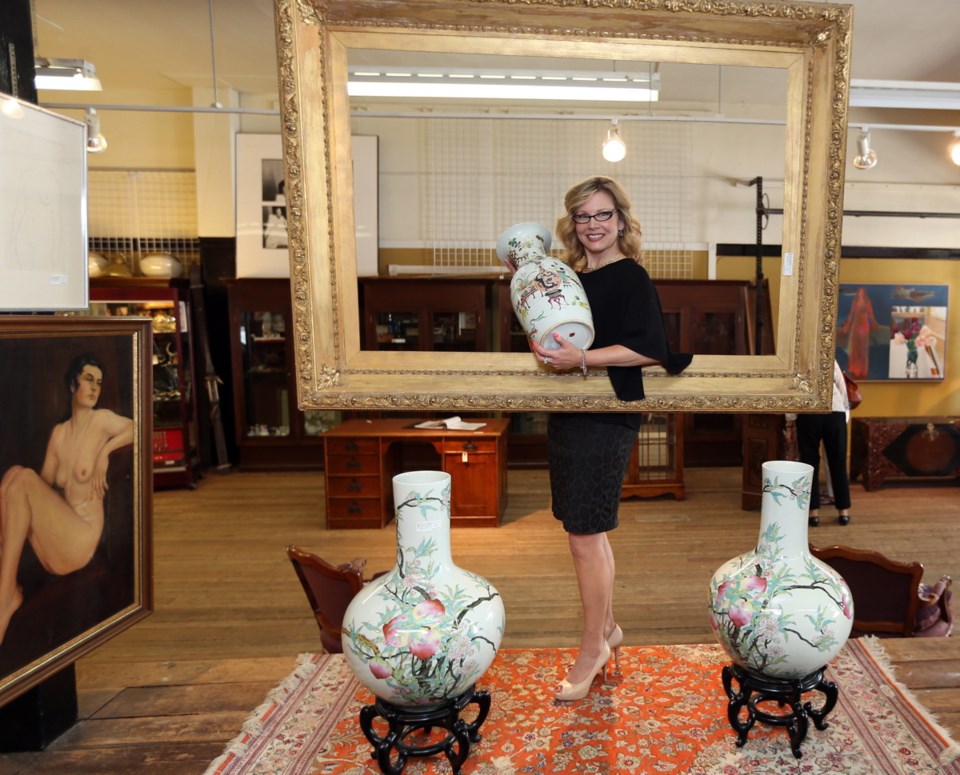Antiques are relics of the past, but these days, it’s modern demographics that are driving sales, says Victoria dealer and auctioneer Alison Ross.
Ross, owner of Kilshaw’s Auctioneers Ltd., says it’s important to keep an eye on what baby boomers are doing, since they form the single-largest age group of buyers and the one with the most money and possessions.
They’re also downsizing. They want to relax and travel and are leaving big family homes to move into smaller spaces.
As the baby boomers downsize, big, awkward Victorian-era tables and sideboards are coming on the market in big numbers. These items still sell, but not at the prices they did a few years ago.
“The market is pretty well saturated with that type of piece now,” says Ross.
Kilshaw’s history stretches back to 1790 in England. The store has been a fixture on Fort Street in Victoria since 1949.
The previous owner, Don Kilshaw, sold the business to Ross in 2006 after she had worked there for eight years as an appraiser.
Ross has a master’s degree in art history from the University of Victoria, but she says her real education comes from seeing, handling and touching antiques and precious objects by the hundreds of thousands as they come through the auction house.
But she also says the Internet and computers give modern antique dealers an advantage over their predecessors. With a global market for antiques, people like Ross can get a good grasp of what’s playing out in places like England or even China.
She cautions, however, that the market is subject to trends. Antiques, historic art and any well-made pieces of furniture or decoration will always find a market. Certain pieces, however, may just not command the prices they once did.
Trends swerve and even reverse.
Baby boomers, for example, are now beyond the age where they want finicky, complicated furniture and possessions.
Things that require a lot of care like delicate antiques are not as popular.
So Scandinavian designs, beginning with things made around the end of the Second World War, with their smooth lines and easy-to-care-for woods, such as teak, are selling well.
These designs are usually well-designed ergonomically and comfortable, a feature now prized in the market.
Ross asks: Would you rather spend a dinner party in a straight-backed Victoria chair or in an ergonomic Swedish design or even a modern one with some comfy upholstery?
“I see some of these antique dining chairs and I’ll raise you a Hans Wegner [Danish chair designer] every time,” she says. “They are so comfortable.”
Meanwhile, knick-knacks, ornaments and trinkets are also not selling in huge numbers.
Modern homeowners, whether retired baby boomers or up-and-coming millennials, are more likely to invest in a single, relatively large piece that makes one strong statement instead of displays of many tiny things.
The single biggest advantage of the one piece, beyond the bold display, is ease of dusting.
Ross says another feature of the modern market is people’s willingness to mix up styles and genres.
Twenty years ago, people were purists in their taste. They would opt to outfit entire living rooms, or even homes, with nothing but Victorian or Edwardian pieces.
Now, the antique dining table can play host to modern padded chairs. Modern and antique artwork can hang together in the same room, or with furniture entirely out of time with the art’s creators.
“It humanizes things,” says Ross. “It allows for a lot more personality.
“With me, my own interests are so varied and my esthetics so broad I don’t want to think of just one theme.
“To me, good design is good design whether it’s 30 years or 10 years old or made today.
“And nowadays people are more concerned with [good design] than they are with how old something is.”
Her own advice to anyone interested in buying antiques or collecting, whether it’s furniture, porcelain tea cups or jewelry, is relatively simple.
First, buy what you love. Don’t think so much about money or investment.
Second, buy the best quality you can afford. Not all antiques were created equal. Good design tends to stand up well over time and last longer.
Finally, Ross firmly believes we should all use and enjoy the pieces we buy.
“Nothing makes me so sad as when I go into some little old dear’s home and seeing her precious China that she got as a wedding present and she has used it three times,” says Ross.
“You can’t enjoy China when it sits in the bottom of a cabinet. If they break, at least you have enjoyed it.
“Objects can be replaced but experiences can’t.”
Markets in China, India heating up
Buyers in emerging markets, such as China and India, are making their presence known in the antique and art world.
Alison Ross, owner of Kilshaw’s Auctioneers Ltd., said the appetite for fine pieces, antique or art, is driven to some extent by a person’s longing to signal success.
But Ross also said cultural differences are evident.
For example, for the Chinese, with a civilization many, many hundreds of years old, the standard 100-year-old antique will not impress.
Meanwhile, fine art, even modern art of living artists, is fetching good prices in India.
Indians are also collecting overseas.
“India is going to be a very interesting market to watch in the next 10 or 20 years,” said Ross.



